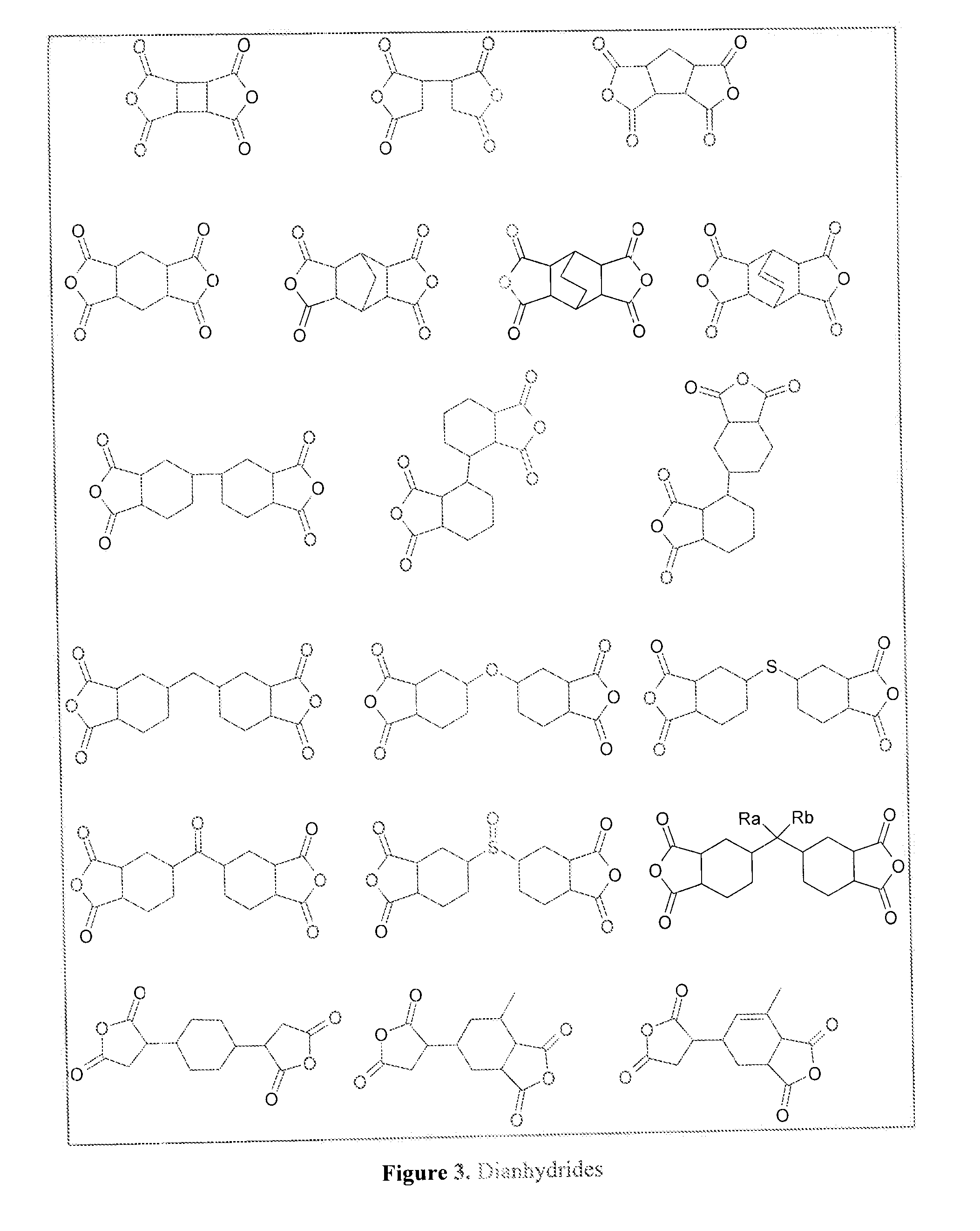Polyamic acid and a polyimide obtained by reacting a dianhydride and a diamine
a technology of dianhydride and diamine, which is applied in the field of polyimide obtained by reacting dianhydride and diamine, can solve the problems of power consumption, deterioration of display quality, response time, etc., and achieve the effects of improving brightness, contrast and switching time, and good or bad, and improving the uniform alignment of liquid crystal materials
- Summary
- Abstract
- Description
- Claims
- Application Information
AI Technical Summary
Benefits of technology
Problems solved by technology
Method used
Image
Examples
example 1
[0062]A polymer backbone which can be referred as polymer main chain is a polyimide or a polyamic acid material. Polyamic acids are the pre-cursor materials of polyimides as shown in a simple example in FIG. 1.
[0063]The polyimide material or its pre-cursors polyamic acid material is prepared from a reaction between a dianhydride and a diamine. A general example of the formation of a polyimide starting from a dianhydride and a diamine is given in FIG. 2.
[0064]The dianhydride which is used to synthesize the claimed polymers is not limited but preferably selected from the materials whose structures are given in FIG. 3 (please see attachment).
[0065]The diamino groups of diamines can be attached to a benzene ring in any of the three patterns, namely, ortho (O), meta (in), or para (p) as shown in FIG. 4. We show these substitution patterns in a general structure as provided in FIG. 5, without wishing to be limited to a benzene ring. Instead of the benzene ring any other aromatic ring stru...
example 2
Synthesis
1. Synthesis of Monomer A
[0069]A complete scheme for the synthesis of monomer A is shown in FIG. 13a).
[0070]In the first reaction amino nitro phenol 1 (6.5 mmol) was coupled with dibromo propane 2 (6.5 mmol) in the presence of potassium carbonate (10.0 mmol) by refluxing in acetone (40 mL) for 24 h. After completion of the reaction, potassium carbonate was removed by filtration and the solvent was evaporated to get the crude product. Final purification was carried out through a column of silica gel by eluting with pentane / ether (6:4) to yield amino nitro ether 3 in ˜80% yield.
[0071]Following the synthesis, amino nitro ether 3 (3.0 mmol) was subjected to further etherification reaction with 4-hydroxy benzaldehye 4 (3.0 mmol) in the presence of potassium carbonate (6.0 mmol) in refluxing acetone (50 mL) for 24 h. After completion of the reaction (TLC confirmation), potassium carbonate was filtered and the solvent was evaporated under reduced pressure to get crude product. Fin...
example 3
Test Displays Prepared Using the Polyamic Acids and the Corresponding Polyimides
[0086]A typical procedure to prepare a test display panel using a newly synthesized polymeric material is as such: In a lithography room, both glass substrates of the display panel are covered with 3% (w / w) polymer solution in NMP (N-methyl-2-pyrrolidon). Or, they are covered with a fresh polyamic acid solution which is directly taken from the reaction mixture (please refer to the synthesis part for the reaction solution / mixture of a polyamic acid). The materials are then spin coated at 200Rps for 10 s, 600Rps for 5 s, 2000Rps for 10 s and 4000Rps for 1 s. The spin coated substrates are then placed in an oven filled with nitrogen (Heraeus thermicon P) and are pre-baked for 3 min at 80° C. and baked for 60 min at 200° C. After the substrates are cooled down to room temperature they are used to sandwich the negative type liquid crystal with spacers (0.5% of 5 μm Hayabead polymer spacer from Hayakawa). Fina...
PUM
| Property | Measurement | Unit |
|---|---|---|
| Temperature | aaaaa | aaaaa |
| Fraction | aaaaa | aaaaa |
| Time | aaaaa | aaaaa |
Abstract
Description
Claims
Application Information
 Login to View More
Login to View More - R&D
- Intellectual Property
- Life Sciences
- Materials
- Tech Scout
- Unparalleled Data Quality
- Higher Quality Content
- 60% Fewer Hallucinations
Browse by: Latest US Patents, China's latest patents, Technical Efficacy Thesaurus, Application Domain, Technology Topic, Popular Technical Reports.
© 2025 PatSnap. All rights reserved.Legal|Privacy policy|Modern Slavery Act Transparency Statement|Sitemap|About US| Contact US: help@patsnap.com



